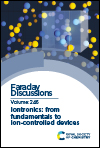Unveiling the capabilities of bipolar conical channels in neuromorphic iontronics
Abstract
Conical channels filled with an aqueous electrolyte have been proposed as promising candidates for iontronic neuromorphic circuits. This is facilitated by a novel analytical model for the internal channel dynamics [T. M. Kamsma, W. Q. Boon, T. ter Rele, C. Spitoni and R. van Roij, Phys. Rev. Lett., 2023, 130(26), 268401], the relative ease of fabrication of conical channels, and the wide range of achievable memory retention times by varying the channel lengths. In this work, we demonstrate that the analytical model for conical channels can be generalized to channels with an inhomogeneous surface charge distribution, which we predict to exhibit significantly stronger current rectification and more pronounced memristive properties in the case of bipolar channels, i.e. channels where the tip and base carry a surface charge of opposite sign. Additionally, we show that the use of bipolar conical channels in a previously proposed iontronic circuit features hallmarks of neuronal communication, such as all-or-none action potentials and spike train generation. Bipolar channels allow, however, for circuit parameters in the range of their biological analogues, and exhibit membrane potentials that match well with biological mammalian action potentials, further supporting their potential biocompatibility.

- This article is part of the themed collection: Iontronics: from fundamentals to ion-controlled devices


 Please wait while we load your content...
Please wait while we load your content...